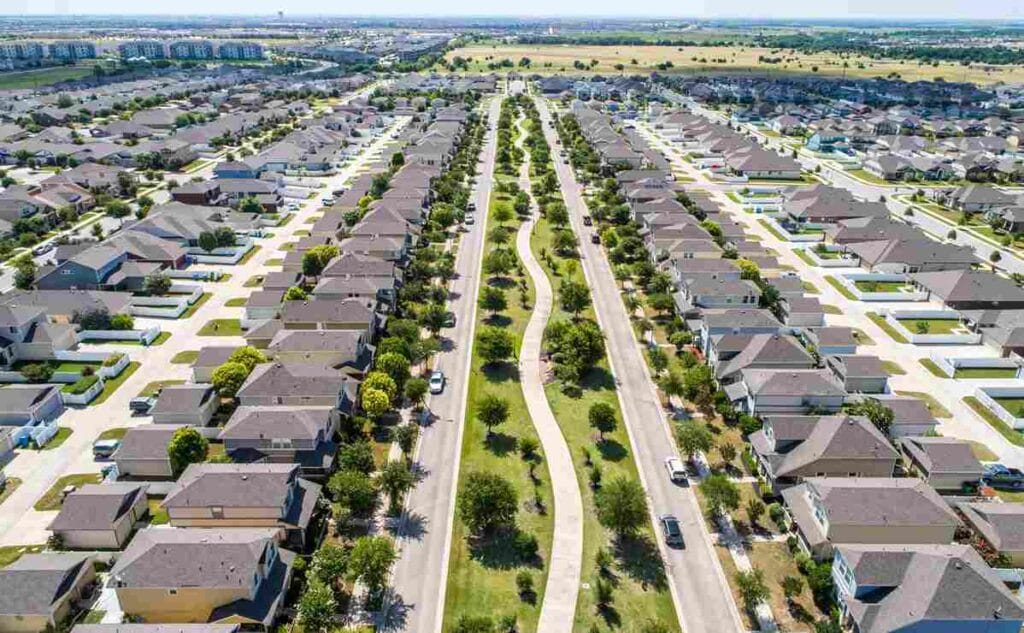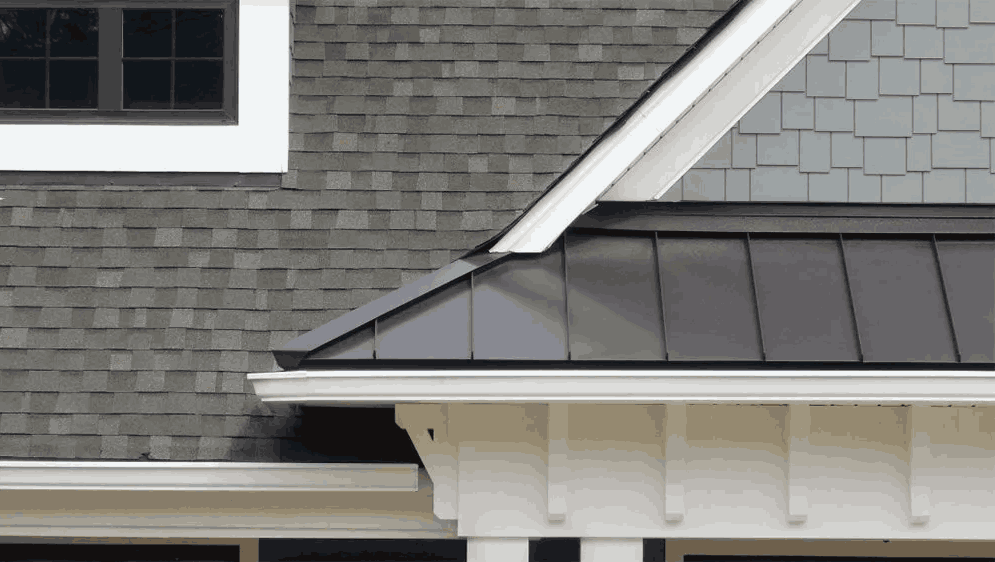
Hail storms can wreak havoc on roofs, causing both visible and hidden damage. Homeowners must understand how to assess hail damage roof issues, navigate insurance claims, and select the right roofing company.
This guide covers everything related to hail damage, from recognizing the signs to understanding the roof insurance inspection process.
Just in 2022 there were over 3,500 reports of severe hail, resulting in billions of dollars in property damage. Insurers, such as State Farm, reported a significant increase in hail claim costs due to the growing number of storms.
The impact of hail isn’t limited to the obvious damage; subtle, unnoticeable issues can also compromise a roof’s integrity and require a trained professional to identify.
What Hail Does to a Roof
Hail can cause various types of damage depending on several factors, including hail size, wind speed and direction, the roof’s material and age, and its slope.
Granule loss on shingles is one common result, exposing the asphalt coating to the elements and accelerating aging. Cracked shingles, exposed fiberglass mats, and weakened self-seal strips are other issues that might not be immediately visible but pose significant risks.
Functional and cosmetic damage can overlap, with even minor-seeming issues like broken edges and granule loss leading to major complications such as leaks and structural wear. Hail impacts can also weaken the shingle seal, leaving it more susceptible to future wind damage.
Common Hail Damage Issues on Shingles
- Granule loss: Often seen in gutters and downspouts post-storm.
- Cracks and fractures: Hard impacts can crack shingles and expose the roof beneath.
- Exposed fiberglass mat: Signals deeper damage that weakens the roof’s structure.
- Weakened self-seal strip: Leads to potential shingle detachment and exposure.
Key takeaway: Even if there are no visible holes, a roof may need an inspection after a hailstorm to detect and address unseen damage.
Determining Hail Damage on Your Roof and Exterior
Determining whether your roof or exterior has hail damage can be challenging. Dents in gutters and downspouts can suggest roof damage, while clogged gutters can indicate granule loss.
Additionally, damaged siding or a marred deck can also point to potential shingle issues. For instance, hail under one inch in size can still dislodge granules or dent surfaces, and even 3/4-inch hail can damage window screens, vinyl siding, and paint on decks.
When inspecting for hail damage, look for:
- Dents on gutters and downspouts.
- Granule accumulation in gutters.
- Damage to siding and outdoor surfaces.
Key takeaway: If any signs of hail damage are present on exterior structures, seek a professional roof inspection for a comprehensive assessment.
The Importance of a Professional Roof Inspection
While homeowners can conduct a preliminary inspection after a storm, a professional roof insurance inspection is essential to document all damage accurately. A professional inspection involves a detailed evaluation of shingles, flashing, underlayment, and other roof elements. The inspector will create a report complete with photographs and detailed notes, which will be crucial for an insurance claim.
Roofing experts play a pivotal role when filing insurance claims. Their reports add credibility, increasing the likelihood of the claim being approved. Partnering with a qualified roofing company for this step can make a significant difference in successfully navigating the insurance process.
Key takeaway: A professional inspection not only provides an accurate assessment but strengthens your case when working with your insurance company.
Can Small Hail Cause Roof Damage?
Yes, hail as small as 3/4-inch can cause roof damage, particularly when accompanied by strong winds. 1-inch hail can result in bruised shingle underlayment and noticeable gutter and fascia damage.
Damage escalates significantly with 1 1/4-inch hail, which can make surfaces appear pockmarked. At 1 1/2 inches or larger, hail damage can be severe, especially if combined with high winds. 2-inch hail or larger often causes severe damage to roofing materials, making it crucial to call a roofing contractor with insurance experience immediately after a storm of this magnitude.
Consequences of Ignoring Hail Damage Roof Repairs
Ignoring hail damage can lead to serious consequences, such as roof leaks or the formation of ice dams, both of which can result in mold, electrical problems, or wood rot.
Mold and wood rot are particularly insidious as they can spread without noticeable signs until they have already caused significant damage, leading to costly repairs. Timely inspection and maintenance can save homeowners from larger issues down the line.
Can Hail Damage to a Roof Be Repaired?
Yes, hail damage can be repaired. Repairs can range from replacing a single shingle to completely replacing a roof, depending on the severity of the damage.
A professional inspection can quickly determine the extent of damage and what repairs are necessary. Most roofing companies offer free inspections, providing homeowners with a cost-effective way to assess damage after a storm. If more than one instance of a dented gutter or damaged siding is found, it is highly recommended to pursue a full hail damage roof inspection.
Key takeaway: Even minor damage can escalate if ignored. Proactive inspections and repairs are essential for maintaining your home’s integrity.
Choosing the Right Roofing Company for Hail Damage Repair
Selecting the right roofing company is crucial for effective hail damage repair. Homeowners should look for companies with experience handling storm damage and insurance claims. Positive reviews, local references, proper licensing, and insurance coverage are all indicators of a reputable contractor.
It’s essential to ask the right questions when evaluating potential contractors. Inquire about warranties on repairs, their experience with insurance claims, and the timeline for project completion. Contractors who have a strong reputation and a track record of success are better positioned to provide reliable repairs and a smoother overall experience.
Key takeaway: Working with a reputable roofing company ensures that repairs are handled efficiently, minimizing stress and maximizing value.
Hail Damage Roof Repair Process Explained
Understanding what to expect during hail damage repair can help homeowners feel more confident about the process. Common repairs include replacing damaged shingles, patching the underlayment to prevent leaks, and repairing or replacing dented flashing. Depending on the extent of the damage, repairs can take anywhere from a day or two for minor issues to a week or more for more extensive damage.
After repairs, it’s wise to adopt preventative measures. Scheduling regular roof inspections after major storms, keeping the roof clean and clear of debris, and applying waterproofing and protective coatings can reduce the risk of future hail damage.
Why Choose Roofer.com for Hail Damage Roof Repair
At Roofer.com, we combine advanced technology with expert service to ensure your roof remains in peak condition.
We stand out for our advanced damage assessment capabilities, comprehensive knowledge of the roofing industry, and a customer-centric approach.
We are here to ensure that your home is protected and that you receive the best possible outcome from your insurance claim. Choose Roofer.com to safeguard your home and peace of mind.
Conclusion
Addressing hail damage roof repairs promptly can protect your home from escalating issues like leaks and structural decay.
Partnering with an experienced roofing company ensures comprehensive assessments and effective solutions. Don’t wait until minor damage becomes costly; schedule a professional inspection today.
Trust Roofer.com for reliable, expert assistance, including seamless insurance claim support. Reach out now to secure your home’s safety and your peace of mind—contact us for your free roof evaluation!




